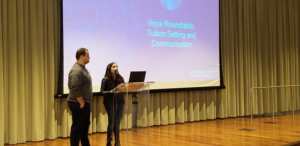
Money from student tuition will fund financial aid, expand mental health resources and improve student housing, university administrators said at the Hoya Roundtable on tuition rate-setting in the Healey Family Student Center Great Room on Nov. 5.
Provost Robert Groves and Chief Operating Officer Geoff Chatas hosted the roundtable in an effort to increase transparency in the tuition rate-setting process. It aimed to address how undergraduate and graduate student tuition rates are decided and how tuition dollars are spent.
Hoya Roundtables enable students and administrators to discuss issues of interest to students including construction projects, housing and transportation for students, according to the Office of the Senior Vice President and Chief Operating Officer website.
The goal of this year’s tuition roundtable was to educate students about the tuition-setting process and tuition use, according to Groves.
“If this is a successful session for you, you will understand a little bit more about how tuition is set, why the amount of tuition is what it is, what we’re doing to invest in the university, what we’re doing to cut costs, and how the whole machinery works over time,” Groves said.
The tuition-setting process begins in the fall semester when the university gathers information from the community about desires for new initiatives, demand for new student services, the anticipated need for financial aid and administrative costs, according to Groves. The Board of Directors then reviews new budget materials in the winter and in the spring semester, the University decides and announces the tuition plan for the following year.
Georgetown is committed to maintaining undergraduate admissions as need-blind and meeting full need and is one of only about two dozen colleges and universities to do so, Groves said.
“We want to allow the brightest undergraduates to come here, regardless of their ability to pay,” Groves said.
About 40 percent of Georgetown’s undergraduate student body received need-based scholarship aid in the last fiscal year, with the University investing $194 million into financial aid in 2018. More than $200 million annually is planned for fiscal years 2019 through 2021.
A priority for the university in the coming years is to increase its funding for developing sexual assault and mental health support services, according to Todd Olson, vice president for student affairs.
“We have added significant funding and significant new staff positions both in CAPS and in the main campus. We’ve also grown in the Law Center and are now growing in the Medical Center as well,” Olson said. “We’ve also staffed up in a related area in Health Education Services, where they do a lot of work on sexual assault, Title IX, alcohol issues, eating disorders, nutrition and health.”
Amid complaints of mold and outdated facilities, the university will also invest more in renovating and updating buildings, dormitories and classrooms, according to Chatas.
“We have to make a continued effort to invest in the deferred maintenance across all of our facilities in the coming years,” Chatas said.
Administrators attempt to address the needs of students, faculty, administrators, financial affairs, and the Office of Advancement as they set tuition each year, Groves said.
“You can think of this as balancing our desires. All of us have more aspirations to build new programs, to build better facilities, to offer more services for students and faculty,” Groves said. “Our aspirations always exceed our ability to pay for them, so we’re constantly juggling what we want to do to make Georgetown even better than it is and what we can do given our resources.”
In order to improve its programs in a cost-effective way, the university will develop a more long-term budget plan, invest in technology and increase fundraising efforts, according to Groves.
“We’re actually being very robust at looking at all of our costs and making sure that every cost is legitimate and needed and managed appropriately,” Chatas said.




















